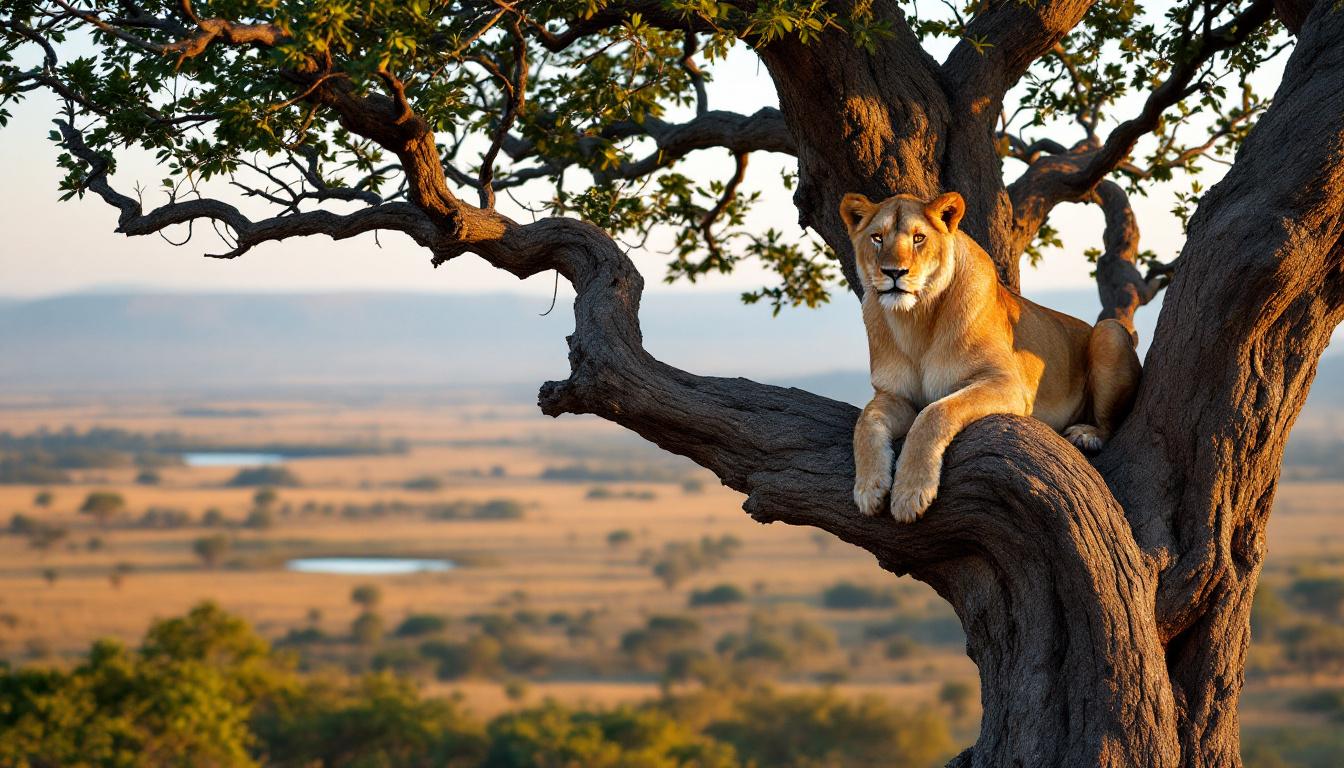Deep in Uganda’s southwestern wilderness lies Queen Elizabeth National Park, a 1,978-square-kilometer sanctuary that defies everything you thought you knew about African safaris. While millions flock to crowded Kenyan reserves, this extraordinary ecosystem harbors wildlife phenomena found nowhere else on Earth.
Here, lions climb ancient fig trees in the Ishasha sector—a behavior documented in only two locations worldwide. Below them, the Kazinga Channel pulses with over 4,000 hippos, creating Africa’s most concentrated aquatic wildlife spectacle. This isn’t just another safari destination; it’s nature’s exclusive masterpiece.
What makes this park truly exceptional isn’t its size—it’s what thrives within those boundaries. With 612 bird species (the highest concentration in East Africa) and 95 mammal species packed into volcanic crater landscapes, Queen Elizabeth delivers biodiversity that larger, famous parks simply cannot match.
Where lions defy gravity and ancient behavior
The fig tree phenomenon that baffles scientists
In the park’s Ishasha sector, massive fig trees dot the savanna like natural skyscrapers—and lions have claimed them as their exclusive domain. These aren’t desperate cats seeking shade; this is learned behavior passed through generations, found only here and Tanzania’s Lake Manyara. Watching a 400-pound lioness gracefully navigate branches 30 feet above ground creates moments that redefine wildlife photography.
The evolutionary advantage hidden in plain sight
Local rangers explain this behavior isn’t random—it’s brilliant adaptation. Tree-dwelling lions escape biting insects, monitor vast territories, and avoid aggressive Cape buffalo herds below. During Uganda’s dry season (June-September), these elevated positions provide strategic hunting advantages that ground-level predators lack. Every sighting feels like witnessing nature’s secret intelligence.
The hippo highway that rules East Africa’s waters
Kazinga Channel’s extraordinary wildlife density
The 32-kilometer Kazinga Channel connects Lakes Edward and George, creating Africa’s most spectacular natural aquarium. Over 4,000 hippos congregate here—the highest concentration per kilometer on the continent. Boat safaris reveal massive pods surfacing like volcanic islands, their territorial displays creating thunderous echoes across pristine waters.
The crocodile kingdom that completes the spectacle
Sharing these waters, Nile crocodiles up to 20 feet long patrol the channel’s depths while elephants wade through shallows, creating scenes straight from prehistoric documentaries. The channel’s nutrient-rich waters support this extraordinary biomass, fed by volcanic minerals from surrounding crater lakes. No other African waterway sustains such concentrated megafauna diversity.
Volcanic craters that created Africa’s bird paradise
The explosion craters hiding flamingo secrets
The Katwe-Kikorongo explosion craters tell tales of ancient volcanic fury that sculpted today’s paradise. Salt-rich crater lakes like Katwe and Bunyampaka attract massive flamingo flocks seasonally, painting pink ribbons across emerald landscapes. These mineral-dense waters, formed by volcanic activity, create unique ecosystems supporting species found nowhere else in Uganda.
The shoebill sanctuary in papyrus kingdoms
Within Kyambura Gorge’s papyrus swamps, the prehistoric shoebill stork—Africa’s most sought-after bird—stalks through cathedral-like vegetation. This “underground forest” harbors primates including habituated chimpanzees, creating multi-layered wildlife experiences. The gorge’s unique microclimate supports species requiring both forest canopy and wetland conditions.
The authentic safari experience mass tourism destroys
Community conservation that protects cultural heritage
Unlike commercialized safari circuits, Queen Elizabeth operates through community-based tourism programs where local tribes actively participate in wildlife protection. The Basongora people, traditional salt miners at Lake Katwe, share ancestral knowledge while benefiting directly from sustainable tourism revenue. This authentic partnership creates experiences impossible in corporate-controlled reserves.
The seasonal advantage smart travelers discover
Visit during December through February when Northern Hemisphere winter drives optimal wildlife viewing conditions. Migratory birds arrive from November to April, while resident species remain active year-round. The dry season concentrates animals around permanent water sources, creating spectacular photography opportunities without Serengeti’s overwhelming crowds.
Queen Elizabeth National Park represents everything authentic African safari should be—tree-climbing lions, hippo highways, volcanic crater ecosystems, and genuine cultural connections. While others chase overcrowded destinations, this Ugandan jewel offers encounters found absolutely nowhere else on Earth.
Book your journey to witness nature’s most exclusive phenomena, where every sunrise reveals wildlife behaviors that exist in only one place on our planet.
